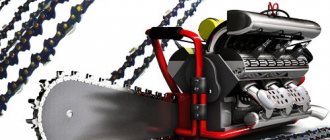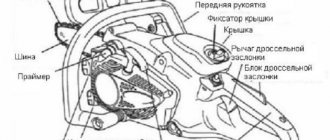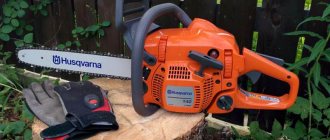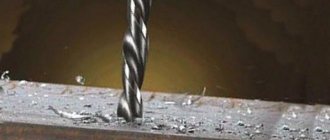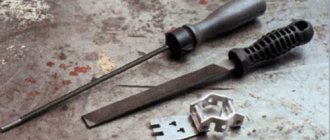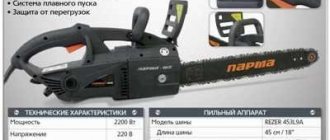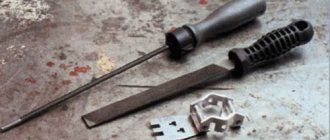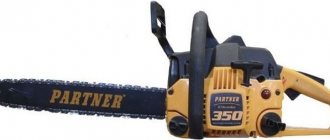To cut logs or large lumber, you need not only a powerful chainsaw, but also a well-sharpened chain. Although you can sharpen a chain with a hand file, if you work a lot, it is better to invest in a good chain sharpening machine. There are stationary and portable models. We'll tell you what to look for when choosing the right model and recommend the best machines for sharpening chainsaw chains.
If you need to sharpen not only chains, but also other tools, such as chisels or knives, then read how to choose a universal tool sharpening machine.
Tools for sharpening chainsaw teeth and reasons for rapid dulling
A chainsaw needs to sharpen its teeth, and this should be done regularly depending on the frequency of use of the tool, which will not only ensure efficient operation, but will also extend its service life. To achieve maximum efficiency from a gas-powered wood cutting tool, you need to learn how to sharpen the chain. There are various devices for this.
Tooth design on chainsaws
All chainsaws need chain sharpening, regardless of their brand and cost. The reasons for the rapid dulling of teeth are:
- Long-term use of the tool. When sawing wood, the metal heats up, so during prolonged operation the resistance of the cutting parts decreases. As a result, the cutting part becomes licked, and the longer you continue to work, the faster dulling will occur.
- Getting under the cutting parts of metal materials, such as nails or screws that are screwed into the wood being cut
- Improper starting and operation of the tool also contributes to rapid dulling of the chain. When starting or while working with the tool, when the chainsaw is on the ground, you need to apply the hand brake. If earth gets into the teeth, this will lead to their rapid dulling and accelerated wear of the chain.
- Type of wood being cut. If hardwood trees are processed, dulling occurs very quickly
For proper sharpening on chainsaws, special round and flat files are used, which are supplied with the tool. These files are designed for sharpening cutting edges in the field. Moreover, it is important to perform this procedure on a cooled instrument.
General criteria for selecting sharpening machines
Disk rotation speed
The speed of rotation of the disk largely determines the speed of processing the material, that is, sharpening the chain. The higher the speed, the faster the chain sharpens. However, there is also a downside: since with high-speed machines the metal is removed from the tooth faster with less exposure time, then with inept handling you can quickly grind down the tooth and ruin the chain if you suddenly set the sharpening angle incorrectly.
Devices with a spindle speed of 2000 to 3000 rpm are considered low-speed, so they are worth buying only if you do not plan to sharpen chains frequently. And for constant sharpening, for example, in forestry or to make money sharpening tools, it is better to buy a device with a wheel rotation speed of 3000 - 7500 rpm. For example, you can take an inexpensive Kalibr-EZS 220 with a speed of 7500 rpm.
Power
This parameter is not key when choosing a sharpening machine for your home. For most machines, the power ranges from 70 to 250 W, and it is quite enough for work. Only a few have engine power that can reach 600 W. Which sharpening machine is better: with a power of 200 or 600 W? For the most part, power affects how the machine will cope with loads, that is, the number of chains sharpened in a short period of time. So, if you sharpen one chain per day, then there is absolutely no point in chasing power. But for constant sharpening, for example, if you earn money from this while sitting in a workshop on the market, a powerful device would be preferable. Let's say from experience that finding a powerful machine at an adequate price is quite problematic.
Grinding wheel dimensions
The original wheel is always included with the saw chain sharpening machine. The thickness of the circles can be from 1.5 to 5 mm - it is not advisable to use thicker ones due to the small pitch of the chain. The thinner the disc, the easier it is to work with, but the wear and tear is much higher. Although in this case it is worth noting that with infrequent use, wear is not particularly noticeable.
- Purchase
How to choose a sandblasting gun for a compressor?
The disk size for such machines is about 100 - 145 mm. This indicator is worth paying attention to when purchasing spare disks. Also pay attention to the diameter of the seat. In some devices it can be 10 mm, and in some 22.3 mm. You can no longer fit circles with a smaller hole on devices with a large mounting socket. But on the contrary, you can use a device such as a dial nut, as is the case with circular saws.
Portable or stationary
The vast majority of the best sharpening machines are stationary, and in order to operate they must first be screwed to the workbench. For regular chain sharpening in a home workshop, a stationary machine is an ideal option.
However, there are also portable machines (not a hand file) that can be used to sharpen chains in the field. For example, while collecting firewood in the forest, you caught a wire with a chain and it became blunt. With this mini machine you can quickly sharpen a chain without returning home. It operates on 12 V, so it can be connected to a regular car battery. True, the quality of sharpening will depend on the professionalism of the master, so if you are planning to buy just such a machine, be prepared to practice a lot. An inexpensive one you can buy is Champion C2002 .
Extra options
For some, additional functions that some models are equipped with may be decisive in choosing a household disk machine:
- Backlight . The backlight really helps out when working in a poorly lit garage, or when someone simply has poor eyesight. It gives better visualization of the chain link being sharpened. Only a few models are equipped with backlighting, although this is a really useful thing.
- Quick access to carbon brushes . The carbon brushes of the motor wear out from time to time and fail. In some devices, to get to them you will have to spin up almost the entire engine. And there are devices in which there is a special hatch on the body, by opening which you can easily remove the carbon brushes without disassembling the entire device and contacting a service center.
Homemade products for sharpening chains
Before starting work with gas-powered tools, you need to sharpen the cutting elements. Before you start sharpening chainsaws with your own hands, you need to determine the design of the cutting edges. The cutting edges of the chains have a lateral and beveled shape (chisel or chipper). The angle of the file during sharpening depends on this.
The design of links on chainsaws
The easiest way to sharpen teeth on an electric or chainsaw is to use the files that come with the tools. Such files can also be purchased at a specialized store that sells gas-powered tools. If you need to sharpen several chains every day, then it is advisable to use a grinder or a special machine.
This is interesting! When working with a grinder for sharpening, it is important to use a voltage regulator, with which you can reduce the number of revolutions.
Features of sharpening teeth using a file
Sharpening with a file begins with the correct choice of the diameter of the device. For 1.3 mm chains, a file with a diameter of 4 mm is used. For cutting teeth measuring 1.6 mm, a file with a diameter of 5.2 mm is used.
Sharpening with a round file
Sharpening with a file must be done directly on the tool, having first secured the tire in a vice and turned on the hand brake. In order for the process to occur quickly, you need to sharpen the teeth first on one side at a certain angle, and then on the other side. The start of work should be marked with chalk or a marker.
Types of files
Using a reciprocating motion with a flat file, the stoppers are removed from the teeth. Beginners are recommended to use a special pattern that is attached to the tire, and all that remains is to make reciprocating movements with a round file. Experienced craftsmen sharpen using only a file, performing reciprocating movements 1-2 times for each tooth.
Chain file
You need to understand that you won’t be able to sharpen a chain with an ordinary round file, much less a flat or triangular file, since a file for a chain must have its own parameters. Although it’s worth making a note here - you can sharpen the depth limiter with a simple flat file.
File parameters for chain sharpening
The most important parameter of a file for sharpening a chain is its diameter. It is important because, depending on the pitch of the chain, a file of a certain diameter is used. Below is a table showing which file is suitable for a chain with a particular pitch.
| Chain pitch (mm) | Link thickness (mm) | File diameter (mm) | Sharpening angle (degrees) | Cutting tooth inclination degree |
| 1/4″(6.35mm) | 1,1-1,3 | 4 | 30 | 0.65 mm |
| 3/8″ Picco/Micro (9.3 mm) | 1,1 | 4 | 30 | 0.65 mm |
| 3/8″ Picco/Micro (9.3 mm) | 1,3 | 4 | 30 | 0.65 mm |
| 3/8″ Picco/Micro (9.3 mm) | 1.3 (for rip sawing) | 4 | 10 | 0.65 mm |
| 0.325″ (8.25 mm) | 1,3 | 4,8 | 30 | 0.65 mm |
| 0.325″ (8.25 mm) | 1,5 | 4,8 | 30 | 0.65 mm |
| 0.325″ (8.25 mm) | 1,6 | 4,8 | 30 | 0.65 mm |
| 0.325″ (8.25 mm) | 1.3-1.6 (for longitudinal sawing) | 4,8 | 10 | 0.75 mm |
| 3/8″ (9.3 mm) | 1,3 | 5,5 | 30 | 0.65 mm |
| 3/8″ (9.3 mm) | 1,5 | 5,5 | 30 | 0.65 mm |
| 3/8″ (9.3 mm) | 1,6 | 5,5 | 30 | 0.65 mm |
| 3/8″ (9.3 mm) | 1.3-1.6 (for longitudinal sawing) | 5,5 | 10 | 0.75 mm |
| 0.404″ (10.26 mm) | 1,6 | 5,5 | 30 | 0.75 mm |
| 0.404″ (10.26 mm) | 1.6 1.3-1.6 (for rip sawing) | 5,5 | 10 | 0.75 mm |
In addition, it is necessary to take into account that most files are sold without a handle. It should be purchased separately. This, of course, does not apply to file sets, in which most files are equipped with handles.
Chain sharpening accessories
Without a doubt, an experienced chainsaw user will be able to sharpen a chain without various auxiliary devices and accessories, which is called “by eye.” But for this you need to have experience, which you must first gain. And this is much more convenient to do with the help of various devices that will allow you to sharpen the chain correctly. Let's look at the most popular of them.
Reference caliber
This device allows you to:
- Check the distance to the depth stop
- Check the sharpening angle of the cutting teeth of the chain
- Clean the groove and measure its depth
- Determine the front angle of the tooth
That is, with the help of a control gauge, after you have carried out preliminary sharpening, you can determine whether it was done correctly. It would be a good idea to take measurements before you start sharpening the chain. Manufactured by Stihl.
Buy a control (filing) gauge 3/8". 0.325"
Clamping holder
This simple device allows you to sharpen the chain at the required height and at the desired angle. It fits tightly to the tooth and limits the depth of the file. And thanks to the risks applied, you will be able to control the required angle. It is necessary to select a holder based on the pitch of the chain being sharpened.
Buy a holder with a file (3.2 mm; 1/4 PM3)
Combined template
Unlike the combination gauge produced by Stihl, the Husqvarna gauge allows not only measuring, but also direct sharpening. Templates also need to be selected according to the chain pitch.
Buy Combined template for chain H25 Husqvarna
Buy Combined template for chain H30 Husqvarna
Guide for holders
Despite the risks applied to the holder, sometimes it can be difficult to accurately maintain an angle, especially for an inexperienced user. Therefore, Stihl offers a special guide FF1, which fits onto the saw bar and allows you to accurately maintain the required sharpening angle.
Buy a guide for the holder
Sharpening template
In addition to combined templates, Husqvarna also produces regular templates, which allow you to maintain the correct angle when sharpening the teeth of chainsaw chains.
Buy a template for low profile chain H36 Husqvarna
Clamping holder 2 in 1
To properly sharpen a chain, two operations must be performed: sharpening the cutting teeth and sharpening the depth stop. Stihl offers a universal solution - a clamping holder for two files, which you can use for both operations at the same time.
Buy a clamping holder (file clamp) 4.0 mm; 3/8″,2 in 1
Buy a clamping holder (file clamp) 4.8 mm; 0.325″,2 in 1
Roller sharpening device Stihl FG4
This sharpening device is installed on the bar, precisely maintaining the required angle, and also allows you to check and adjust the cutting depth limiters on the chain.
Buy roller sharpening device Stihl FG4
Chain sharpener Stihl FG 2
When using this device, the chain must be removed from the chainsaw. This is one of the most accurate devices with which you can sharpen a saw chain for a gasoline saw.
Buy chain sharpener Stihl FG 2
Clamp
In field conditions, a clamp allows you to clearly fix the tire for precise sharpening.
File sets
Sets of files, depending on the manufacturer, may contain the following devices:
- Round file(s) of various diameters
- Flat file
- Templates
- Holders
- Reference caliber
Stihl sets
Sharpening set (4.0 mm) Stihl 56050071027
Chain sharpening kit from a well-known manufacturer. Set contents: Round file 4 mm; The file is flat; Caliber
Buy a sharpening set (4.0 mm) Stihl for chains
Sharpening set d4.8 mm for 0.325 Stihl 56050071028
Chain sharpening kit from a well-known manufacturer. Set contents: Round file 4.8 mm; The file is flat; Caliber
Buy sharpening set d4.8 mm for 0.325 Stihl for chains
Husqvarna kits
Sharpening set for 3/8 inch chains, 1.3 mm
Chain sharpening kit from a well-known manufacturer. Set contents: Round file 4 mm - 2 pieces; The file is flat; Combined template; Lever
Buy Husqvarna Hobby sharpening set
Chain sharpening kit 0.325 0.325 inch
Chain sharpening kit from a well-known manufacturer. Set contents: Round file 4 mm - 2 pieces; The file is flat; Combined template; Lever;
Buy a chain sharpening set from Husqvarna
3/8" chain sharpening kit; 1.5 mm
Chain sharpening kit from a well-known manufacturer. Set contents: Round file 4 mm - 2 pieces; The file is flat; Combined template; Lever;
Buy a sharpening set for Husqvarna chains
H37 3/8" chain sharpening kit
Chain sharpening kit from a well-known manufacturer. Set contents: Round file 4 mm - 2 pieces; The file is flat; Combined template; Lever;
Buy a sharpening set for Husqvarna chains
Sharpening on special manual and automated machines
If a tooth has significant wear, restoring its sharpness will be problematic. For such purposes, special manual machines are used, the functioning of which is carried out in the following way:
- The screw for adjusting the clamp is loosened
- The direction of the links is aligned on the saw, which should face the sharpening stone
- The required angle is set
Manual precision sharpening machine
Deep sharpening will negatively affect the strength of the teeth, so you may soon need to replace the chain. After completing the work, you can begin to remove the metal edge using a compressor. It doesn't hurt to place the entire device in oil for a few hours.
For sharpening, automated machines are used, on which the chain is placed and fixed. The device is fixed in the tool, after which the engine starts. Chains on which it is impossible to sharpen the teeth with a file need such sharpening.
Automated machine
How to sharpen teeth with a grinder
If an automated sharpening machine seems expensive, then a grinder can replace it. This tool should be used as a sharpening machine if you have extensive experience working with angle grinders. If you work with an angle grinder incorrectly, it can not only harm your health, but also the chain itself, the teeth of which will be incorrectly sharpened.
The principle of sharpening with an angle grinder is as follows:
- The chain remains on the tool
- The sharpening angle is visually selected
- The tool is turned on at half power using a connected voltage regulator
Sharpening with a grinder
Each tooth must be sharpened with a grinder. If the angle is chosen incorrectly, it will be possible to determine this already at the first launch of the tool.
How to sharpen a chainsaw chain yourself
- The first step is to select the required diameter of the round file. The table above shows the diameters depending on the chain pitch.
- Before sharpening, be sure to thoroughly clean the chain of sawdust, resin and other “extra” items. This can be done using a special product, a soft metal brush, or improvised means.
- Sharpening chain cutting teeth. If you use a round file without additional devices, then you need to firmly fix the file and maintain the correct angle (for cross-cutting chains it is 30 degrees, and for longitudinal sawing it is 10) and move the file back and forth. In this case, it is advisable to press on the file only when moving forward. You should start with the shortest tooth.
- If you have a control device, then after you are sure that the tooth has been sharpened, you need to check it.
- If you have nothing to check the correct sharpening, then advice from Stihl will help: light should not be reflected from the cutting edge.
The light is reflectedNo light reflected
- After sharpening the cutting edges of the teeth, you also need to sharpen the depth stops. It is especially convenient to do this using a control gauge from Stihl, but it can also be done manually or using other devices.
Homemade device for sharpening chainsaw chains with your own hands
It is recommended to make homemade devices for sharpening chainsaw chains in cases where you have to sharpen the chain on the tool every day. This homemade device is an electric motor with an abrasive disc attached to the shaft. It is necessary to use an abrasive disc, since it is impossible to perform this procedure with a grinding wheel.
The principle of making a homemade machine is that the engine should be of low power and fixed to the base. A special template is made on which the cutting element of the tool is fixed. A rotating disk together with a motor is manually brought to each tooth, and they are sharpened. It is important that the engine is movable and the chain is fixed in a stationary state.
Such a device (from a low-power electric motor) is the best option for those who are engaged in professional sharpening. Additionally, you can also make a special template for securing the device. This will reduce the need to manually adjust the angle.
This is interesting! Practice shows that Chinese teeth sharpening machines are popular due to their efficiency. Their main disadvantage is the cost, but if you have such a device at home, you can earn extra money from it.
As a conclusion, it should be noted that the chain is an important device in every chainsaw. It needs regular sharpening, and the longer you do not sharpen the teeth, the sooner the time will come to replace the device. It is important to understand that working with a tool with blunt teeth puts a lot of stress on the engine.
Who is the machine suitable for?
The sharpening device is definitely worth purchasing for the following categories of chainsaw owners:
- Owners of good quality equipment and consumables . Using the machine will allow you to sharpen using technology, minimizing the risk of ruining a good chain with “crooked hands.”
- For professionals who work in difficult conditions felling trees . In the unit of time that even an experienced person can spend on getting the chain into working condition, he can cut down several trees and earn money. If we are talking about a team, then we generally need a person who will only do sharpening. It is much more cost effective to purchase a machine. Most devices are electric, so their installation is advisable at a base or winter hut. Each lumberjack has two or three chains, he changes them during the day, and upon his return he sharpens them for the next working period.
- Inexperienced owners who have recently purchased a saw are going to use it at home, but they do it a little and a lot . For example, for regular firewood collection or during the construction of wooden structures. In this case, purchasing a machine will help make high-quality sharpening and sooner or later will recoup the money, and most importantly, the time saved thanks to the device.
At the same time, you need to honestly identify those people for whom it makes no sense to purchase a sharpening unit. This may be the case if the chainsaw is used very rarely, and the work being performed is not a responsible one. It is better to purchase another chain and replace it if it becomes dull, and then sharpen it in a workshop.
